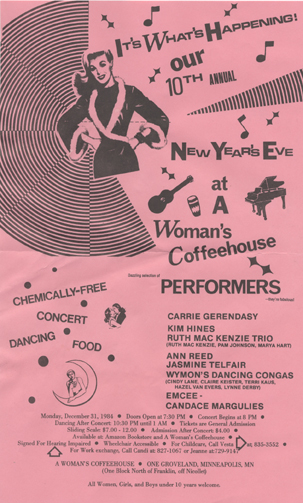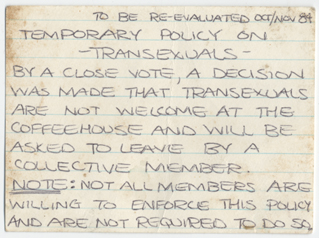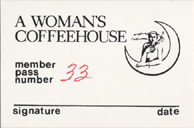Difference between revisions of "A Woman's Coffeehouse"
| Line 27: | Line 27: | ||
| − | In a 1985 flyer, the collective announced “some of our main goals are to bridge the cultural gaps between white women and women of color and break down the walls of alienation that have been built up over the years.”<small>(3)</small> That same year, approximately half of the patrons were people of color, and the same balance existed on stage. | + | In a 1985 flyer, the collective announced “some of our main goals are to bridge the cultural gaps between white women and women of color and break down the walls of alienation that have been built up over the years.”<small>(3)</small> That same year, approximately half of the patrons were people of color, and the same balance existed on stage. |
Revision as of 22:55, 18 March 2010
1900 Nicollet Avenue, Minneapolis, MN. (1975-1988)
|
The Coffeehouse hosted an immensely popular New Years Eve celebration. Image Courtesy of the Jean-Nickolaus Tretter Collection. |
Begun in 1975 at the Lesbian Resource Center,(1) the collectively-owned venue was an apparent first—it offered a chemically free late-night venue for queer women that did not enjoy the bar scene at Ladies Night, Foxy's Bar, or The Town House Bar.
|
In a 1985 flyer, the collective announced “some of our main goals are to bridge the cultural gaps between white women and women of color and break down the walls of alienation that have been built up over the years.”(3) That same year, approximately half of the patrons were people of color, and the same balance existed on stage.
|
The coffeehouse predated the 1980s lesbian bar scene in St. Paul, and eventually the business model proved ineffective. Women who abstained from alcohol grew tired of the venue, and began going to lesbian-friendly bars to dance with other women. Membership dwindled, and the organization closed in 1988.(4)
|
The Coffeehouse was a site of constant scandal--this card is the product of a controversial decision to ban transgender people from participating. Courtesy of the Jean-Nickolaus Tretter Collection. |
Membership card, courtesy of the Jean-Nickolaus Tretter Collection
(1)Enke, Anne. Finding the Movement: Sexuality, Contested Space, and Feminist Activism. North Carolina: Duke University Press, 2007. Page 224.
(2)Enke, page 225.
(3)Anderson, Shelley. “Coffeehouse Makes Changes.” Equal Time, 12/18/1985. Page 9.
(4)Enke, Anne. Page 250.
Part of Minneapolis/St. Paul, MN: 100 Queer Places in Minnesota History, (1860-1969), (1969-2010)


